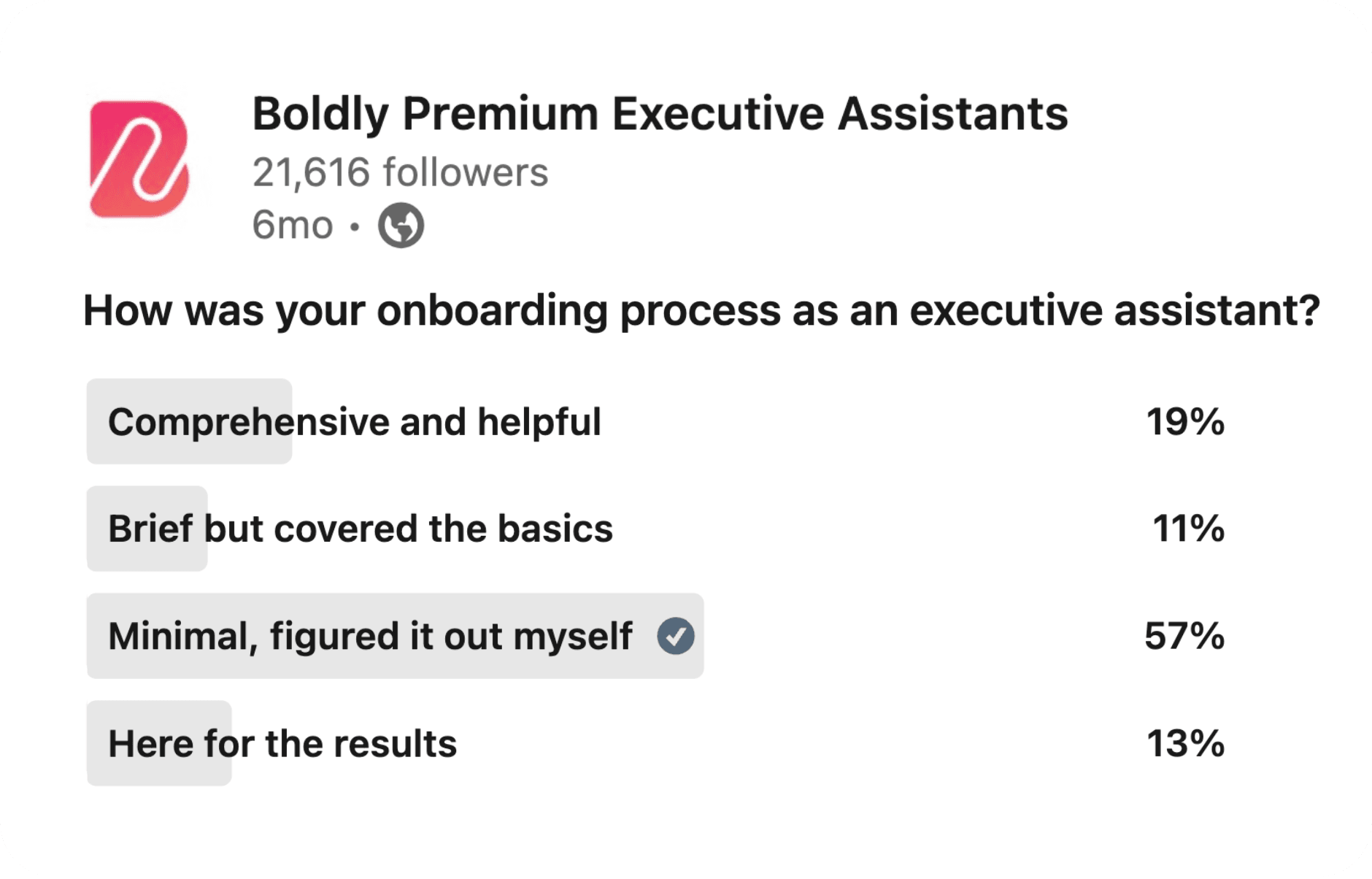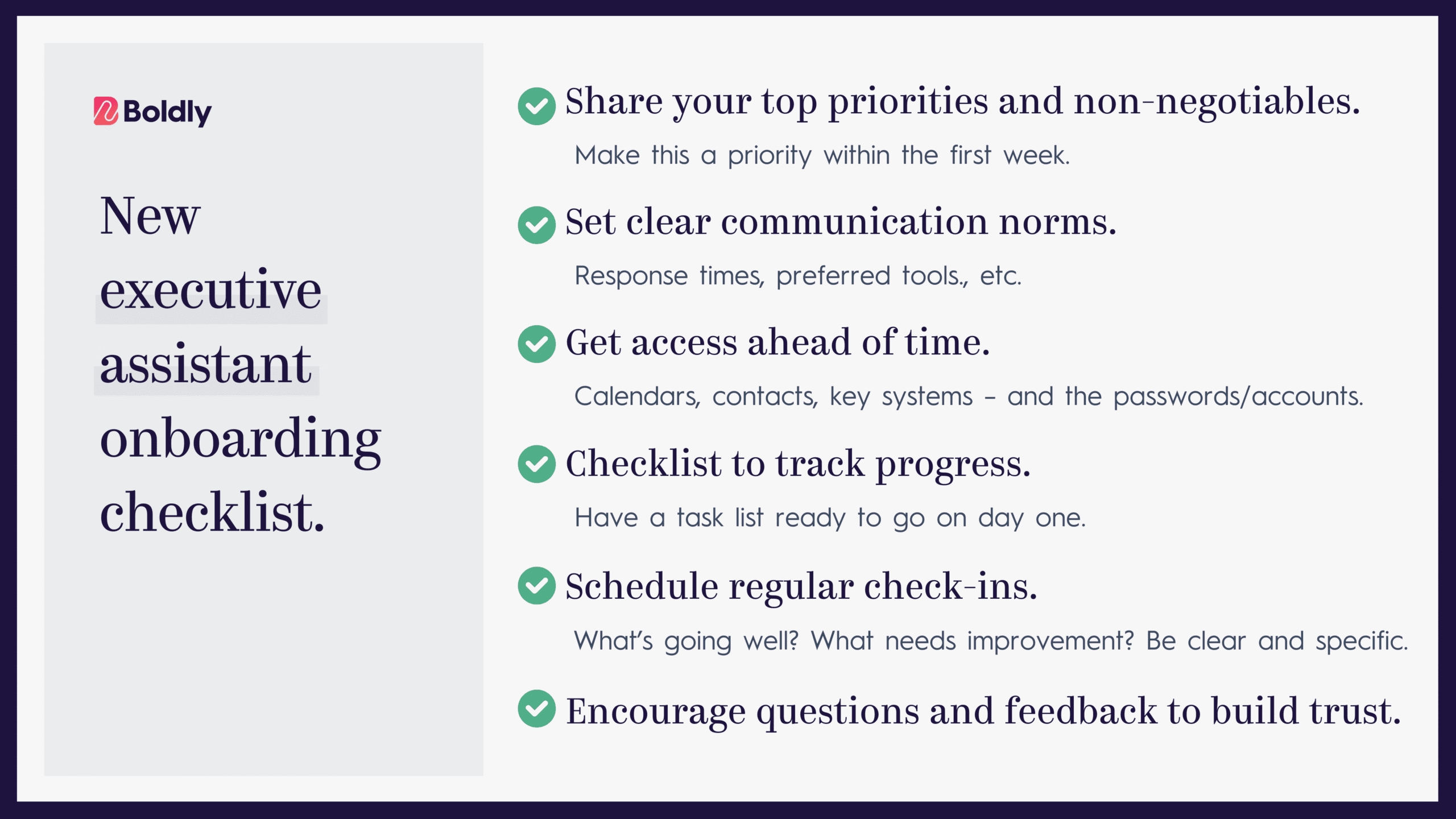More than half of all executive assistants leave within two years.
Turnover isn’t uncommon in the executive assistant role. Unfortunately, neither is a comprehensive onboarding. When we asked our LinkedIn community of executive assistants about their experience, more than half said it was minimal — and they had to figure it out on their own.


Whether your assistant is moving up or moving on, you’ll need to restart the hiring process and the long journey of building trust with a new EA.
You can make that transition a little less difficult with a few simple steps. No need to dread a change in executive assistants or experience a slowdown in productivity — here are our top tips (and checklists) for a seamless transition.
Allow For Overlap When Onboarding A New Executive Assistant
Ideally, you’ll bring on your new executive assistant while your current one is still present to provide one-on-one training and support to help the transition go smoothly. This approach is particularly valuable when transitioning a C-level executive assistant who manages complex, high-stakes responsibilities that require a nuanced understanding of executive preferences and company dynamics.
With this arrangement, there is a higher likelihood of a practical and in-context knowledge transfer. And, just as important as anything, it can help with morale and engagement on your team. Having a trusted team member train and give the seal of approval to someone new goes a long way!
One-on-one transition training also makes immediate feedback possible. Questions that pop up while observing or doing daily tasks get answered not with just a how-to, but with an explanation of why something is done that way.
Yet, while overlap is ideal, it’s not always possible.
Hiring an executive assistant takes time, and it might not fall within the window of your current executive assistant’s exit plans. This is when high-quality documentation comes in handy.
Create Documentation Of All Executive Assistant Duties
If you’re in a situation where overlap between executive assistants won’t be possible, you’ll need a documentation plan that can be handed off to a new team member.
At Boldly, our team regularly creates standard operating procedures (SOPs) for all client work.
SOPs are written instructions that help define how routine tasks are to be done. Standard operating procedures are vital in some industries, such as medical, manufacturing, or financial, and in some cases, required by law. Regardless, they are a good idea.
Standard operating procedures should:
- Be clear and concise.
- Simplify procedures down to manageable steps.
- Be regularly reviewed and updated, keeping one version fresh for everyone.
- Be easily understood.
- Be written in a way that is end-user or new-user friendly and doesn’t require inside knowledge.
When done correctly, SOPs create:
- Better efficiency. SOPs streamline workflows so you don’t have to reinvent the wheel every time.
- Consistency. SOPs are a framework that make sure work and tasks are done the same way, meeting established expectations. A consistent process is necessary for effectiveness.
- Protection. By knowing that team members are trained the same way, the likelihood of someone developing erroneous habits or other problematic behavior that impacts the workplace is reduced. SOPs also provide a reference guide on tasks that aren’t done as frequently.
- Goal alignment. SOPs are a guide to keeping a team on track with the executive’s goals.
- Better communication. SOPs standardize work in a way that makes it easier to both collaborate and communicate what needs to be done.
- Better onboarding. With SOPs, onboarding is easier because guidelines, instructions, and expectations are spelled out for new team members. Their questions can be answered within the SOP.
It’s that last point that matters when it comes to a successful transition to a new executive assistant. Boldly executive assistants create SOPs for all of those reasons, but they are particularly mindful that things can easily be covered if emergencies come up.
Whether or not you choose to create a formal SOP, just know that it’s a good idea to document important information.
Your EA shouldn’t be the sole holder of any passwords, systems knowledge, or contacts. This should always be documented and available to other team members who need to know. No one should walk out the door with the keys to the company, essentially.
Sample Standard Operating Procedure (SOP) For Executive Assistants
Good documentation doesn’t thrill most employees, but it’s one of the best ways to ensure you’re covered during vacations, emergency leave, or turnover.
Keeping an updated Standard Operating Procedure (more commonly known as an SOP) should be a regular part of your executive assistant’s job.
Ideally, this should be a priority that begins on your EA’s first day — not something to cram into their last week!
An executive assistant’s SOP should comprehensively document every executive assistant duty to ensure seamless knowledge transfer.
An Executive Assistant Standard Operating Procedure (SOP) should include:
- A list of all the executives the EA is supporting along with their:
- Scheduling preferences
- Travel preferences
- Meeting preferences
- Communication and contact preferences
- Zoom, Slack, email, and any other technology
- Important colleagues, direct reports, and/or partners along with their:
- Contact information
- Time zone (if applicable)
- Link to their calendar (if applicable)
- Key scheduling, inbox, or travel notes
- An overview of the EA’s daily tasks, responsibilities, and projects
- Frequently used tools and applications
Learn Why Your Executive Assistant Is Moving On
This may not always be the best way forward — if your assistant is leaving on uncertain or tense circumstances, it may be best to let HR cover this in an exit interview.
However, understanding the specific factors that lead to turnover can be valuable. An article from Medium explains why one former EA “will never be an executive assistant again,” citing around-the-clock high stress, lack of mobility or job advancement, and navigating complex personalities.
The top reasons an executive assistant leaves tend to be:
- Burnout and overwork.
- Lack of growth or professional development opportunities.
- Challenging relationships with their executive or other team members.
- Change in role and responsibilities.
- Professional or career shift.
- Changes in situations in their personal lives.
If your executive assistant is leaving on good terms, you can have a conversation to learn more — and to get some insights into what you can do to improve the role for the next EA.
While HR should be responsible for the formal executive assistant exit interview, you can learn if there are operational changes that need to be made. You may ask some final questions about projects or clients to make sure all bases are covered. Perhaps you can verify that the SOP is up to date.
At the very least, it’s one final chance to ask your trusted executive assistant for feedback.
They may more freely communicate valuable insights that can genuinely help improve things. There are likely things executive assistants wished their execs knew, and this is your opportunity to find out.
Day-One Readiness Checklist For Your New Executive Assistant
While a premium EA should ultimately lead the transition process once they’re in position, having these essentials ready can speed up their effectiveness and show your commitment to their success from day one:
Technology Setup
- Email access and signature setup
- Calendar permissions and scheduling tools
- Access to project management systems
- Phone system and voicemail setup
- Travel booking platforms and corporate accounts
Essential Information
- Updated contact database with VIP classifications
- Recent calendar patterns and recurring meetings
- Current project status reports
- Vendor and service provider contacts
- Office procedures and building access
Clear Communication Expectations
- Response time expectations for different communication types
- Delegation boundaries and decision-making authority
- Confidentiality protocols and sensitive information handling
Onboarding a new EA is more than setting up accounts. It’s about building trust and a strong partnership from day one. Here’s a quick, practical checklist to help your new executive assistant feel supported, confident, and ready to make an impact.

Essential Questions To Ask Your Team During Your EA Transition
Beyond having systems and information ready, successful integration requires ongoing dialogue.
Consider these questions during the onboarding process:
For Process Optimization
- What current workflows could be streamlined or eliminated?
- Which recurring tasks could be systematized for greater efficiency?
- How can we better prioritize incoming requests and communications?
For Strategic Partnership
- What level of decision-making authority should the EA have in different scenarios?
- How can the EA contribute to strategic initiatives beyond administrative tasks?
- What professional development would enhance their value to the organization?
For Long-term Success
- What would make this role compelling enough to keep top talent?
- How can we measure and celebrate EA contributions to organizational success?
- What backup systems need to be in place for coverage during absences?”
Setting Up Your New EA For Success
Having the right tools and information ready is just the beginning.
Once your new executive assistant is onboarded, you’ll need to establish clear performance expectations for long-term success. Be sure to discuss:
- Calendar management efficiency
- Communication responsiveness
- Project coordination success
- Proactive problem-solving instances
- Professional development initiatives taken
Regular check-ins about these things during the first 90 days help identify any gaps in communication about the executive assistant duties and responsibilities and make sure they are aligned with your specific needs.
The Best Way To Avoid A Challenging Transition
While these strategies and checklists can significantly improve your EA transition, the most effective approach is working with a service that handles these complexities for you. If you need a new executive assistant quickly, Boldly can help make this transition process much easier.
We took all of the pain points—hiring costs, legal compliance concerns, talent level, industry-specific concerns, flexibility, affordability—and created a simple solution.
Our premium EAs are equipped to lead the transition process themselves, handling everything from initial setup to performance optimization. If the partnership isn’t working out as expected, we can quickly pivot to find a better match, removing the typical risks associated with traditional hiring.
We’d love to have a conversation with you, even if you’re only in the preparation stages for potential changes ahead.




